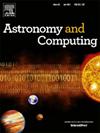Classifying the clouds of Venus using unsupervised machine learning
IF 1.8
4区 物理与天体物理
Q2 ASTRONOMY & ASTROPHYSICS
引用次数: 0
Abstract
Because Venus is completely shrouded by clouds, they play an important role in the planet’s atmospheric dynamics. Studying the various morphological features observed on satellite imagery of the Venusian clouds is crucial to understanding not only the dynamic atmospheric processes, but also interactions between the planet’s surface structures and atmosphere. While attempts at manually categorizing and classifying these features have been made many times throughout Venus’ observational history, they have been limited in scope and prone to subjective bias. We therefore present and investigate an automated, objective, and scalable approach for their classification using unsupervised machine learning that can leverage full datasets of past, ongoing, and future missions.
To achieve this, we introduce a novel framework to generate nadir observation patches of Venus’ clouds at fixed consistent scales from satellite imagery data of the Venus Express and Akatsuki missions. Such patches are then divided into classes using an unsupervised machine learning approach that consists of encoding the patch images into feature vectors via a convolutional neural network trained on the patch datasets and subsequently clustering the obtained embeddings using hierarchical agglomerative clustering.
We find that our approach demonstrates considerable accuracy when tested against a curated benchmark dataset of Earth cloud categories, is able to identify meaningful classes for global-scale (3000 km) cloud features on Venus and can detect small-scale (25 km) wave patterns. However, at medium scales (500 km) challenges are encountered, as available resolution and distinctive features start to diminish and blended features complicate the separation of well defined clusters.
利用无监督机器学习对金星云层进行分类
由于金星完全被云层笼罩,因此云层在金星的大气动力学中发挥着重要作用。研究金星云层卫星图像上观测到的各种形态特征不仅对了解大气动态过程至关重要,而且对了解金星表面结构与大气之间的相互作用也至关重要。虽然在金星观测史上曾多次尝试对这些特征进行人工分类和分级,但范围有限,而且容易产生主观偏见。因此,我们提出并研究了一种自动、客观和可扩展的方法,利用无监督机器学习对这些特征进行分类,这种方法可以充分利用过去、现在和未来任务的完整数据集。为了实现这一目标,我们引入了一个新颖的框架,从金星快车和 "赤月 "任务的卫星图像数据中生成固定一致尺度的金星云层天底观测斑块。我们发现,我们的方法在与地球云类别的基准数据集进行测试时表现出相当高的准确性,能够识别金星上全球尺度(3000 千米)云特征的有意义类别,并能探测到小尺度(25 千米)的波浪模式。然而,在中等尺度(∼500 千米)上却遇到了挑战,因为可用的分辨率和独特的特征开始减弱,而且混合特征使得分离定义明确的云团变得更加复杂。
本文章由计算机程序翻译,如有差异,请以英文原文为准。
求助全文
约1分钟内获得全文
求助全文
来源期刊

Astronomy and Computing
ASTRONOMY & ASTROPHYSICSCOMPUTER SCIENCE,-COMPUTER SCIENCE, INTERDISCIPLINARY APPLICATIONS
CiteScore
4.10
自引率
8.00%
发文量
67
期刊介绍:
Astronomy and Computing is a peer-reviewed journal that focuses on the broad area between astronomy, computer science and information technology. The journal aims to publish the work of scientists and (software) engineers in all aspects of astronomical computing, including the collection, analysis, reduction, visualisation, preservation and dissemination of data, and the development of astronomical software and simulations. The journal covers applications for academic computer science techniques to astronomy, as well as novel applications of information technologies within astronomy.
 求助内容:
求助内容: 应助结果提醒方式:
应助结果提醒方式:


